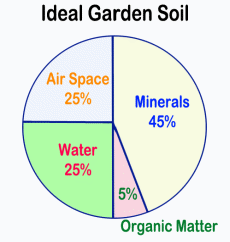First of all, remember that "Soil is
NOT dirt." Many people use the terms interchangeably but
there is a difference. Soil is a combination of mineral
particles and elements that has a specific structure
able to support plant life. Dirt is what you sweep up
off the floor. It has no structure or any of the
chemical or biological elements that support plant life.
 As we discussed in the Site Conditions
Section, soil is made up of three mineral particles,
sand,
silt and
clay. The percentage of each of these
three particles will determine the type and
characteristic of soil you have in your beds or borders.
In addition, soil will include open spaces called pores
which will be filled with either air or water. Topsoil
suitable for plant growth will also contain decomposing
plant or animal life called organic matter which will
provide some nutrients but will also be the home of
beneficial organisms such as certain bacteria, fungi and
earthworms.
As we discussed in the Site Conditions
Section, soil is made up of three mineral particles,
sand,
silt and
clay. The percentage of each of these
three particles will determine the type and
characteristic of soil you have in your beds or borders.
In addition, soil will include open spaces called pores
which will be filled with either air or water. Topsoil
suitable for plant growth will also contain decomposing
plant or animal life called organic matter which will
provide some nutrients but will also be the home of
beneficial organisms such as certain bacteria, fungi and
earthworms.
An ideal soil for the growth of the vast majority of
landscape plants would consist of 45% minerals which
come from the basic rocks that were ground down over the
millennia into soil size particles. As mentioned
previously, ideally, the soil type would fall into that
"loam" area on the soil triangle.
It would contain pore spaces that would consist of 25%
of the soil volume that would be open and filled with
air. The roots of plants need to be in contact with
oxygen in order to stimulate proper growth. If these
pores are filled with water rather than air or are
non-existent, the roots will not grow and may rot.
Another 25% of the volume of the soil should be filled
with water. Of course, water is essential for plant
growth for a number of reasons, one of which is as a
solvent for the nutrients needed by the plants. The
water and nutrient mix is the way that the elements can
move into the roots. If too much of the pore space is
filled with air instead of water, a droughty condition
will exist and will result in the plants wilting. (BTW -
Ironically, if the air space is filled with water i.e.
the soil is saturated, the roots will close down and
cause the plant to wilt too.)
The final 5% of the soil volume should consist of
organic matter (OM) which is important for several
reasons. One is that it helps to moderate the negative
traits of both sand and clay. Adding large amounts of
organic matter to sandy soils will "clog" up some of the
large pores and intercept water and hold nutrients. In
clay soils, OM will cause a type of clumping which forms
bigger particles that allow for larger pore spaces. This
will help to increase the flow of water and improve
drainage and oxygen content of the soil.
Related Articles: Soil Composition
- Cation Exchange Capacity -
Soil Profile -
Fixing Soil Problems - Dealing with Soil
Problems - Soil Test



